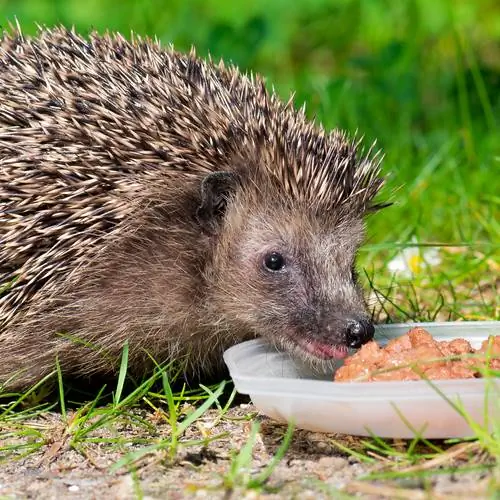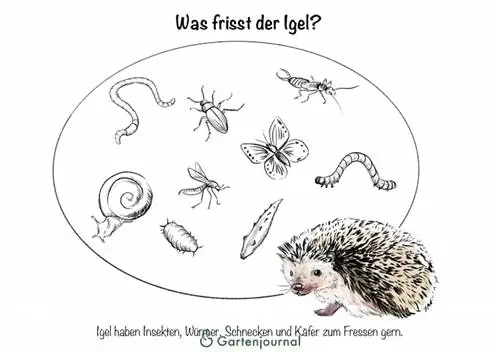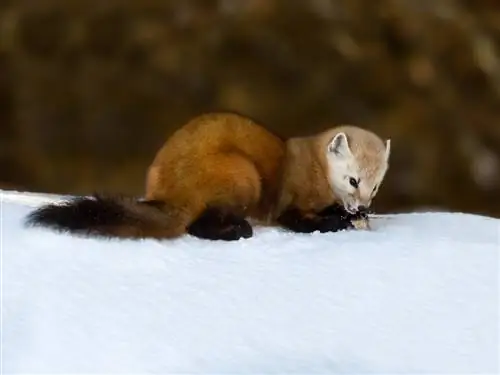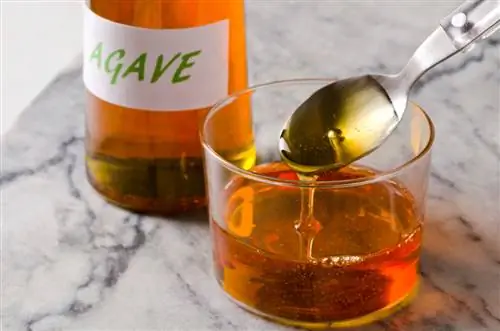- Author admin [email protected].
- Public 2023-12-16 16:46.
- Last modified 2025-01-23 11:21.
The ideal hedgehog world has long since fallen apart. Destruction of their habitats and extensive use of pesticides have fatal consequences for the daily bread of the lovable prickly balls. Feeding is no longer a question of yes or no, but when and how. Read this guide on how to properly feed hedgehogs in the garden.

When and how should you feed hedgehogs?
Feeding hedgehogs properly means primarily offering insects and worms, but if food is scarce, cat or dog food, oatmeal and scrambled eggs can also be given. Feeding is particularly advisable in autumn and winter, but should be limited in time to avoid dependencies.
Feed hedgehogs in summer and winter?
Shrinking habitats, insect extinctions and climate change are not leaving wildlife unaffected. More and more garden owners are setting up feeding stations to compensate for the lack of food for hedgehogs and other insect eaters. From the experts' point of view, this measure is good and right as long as the support is limited to a clearly defined period of time. However, there are downsides to consider. The following table summarizes the advantages and disadvantages of year-round feeding for hedgehogs:
| Advantages | Disadvantages |
|---|---|
| Compensate for food shortages | Food envy and social stress |
| Preventing the consequences of drought | Infection source feeding place |
| Mitigate habitat loss | poor feed quality |
| Prevent weakening of the immune system due to lack of food | Inbreeding |
| Mating fights | |
| Loss of natural independence | |
| Overweight |
Explanations of the benefits
Insect extinction and species decline can no longer be denied. Climate change is making matters worse with long-lasting heat and bone-dry soil. In summer, the already stagnating population of insects and molluscs often hide deep in the ground, out of reach of starving hedgehogs. In order to get their fill, the insectivores have to walk far. Shrinking habitats fragmented by roads, functional gardens turned into gravel dumps and insurmountable concrete walls make life difficult for hungry hedgehogs. The resulting malnutrition massively weakens the immune system, making it easy for diseases and parasites. From this point of view, setting up feeding stations makes sense.
Explanations of the disadvantages
Hedgehogs are by nature solitary creatures who respectfully avoid each other. Meetings are unavoidable at feeding stations. Social stress and food envy create an aggressive climate that leads to real boxing matches. Weakened hedgehogs, who are particularly dependent on additional food, lose out. Hedgehogs defecate wherever they are. This makes every hedgehog feeding place a dangerous source of infection, even if cleaned daily. When people are close together at the food bowl, pathogenic pathogens are simply passed on.

A feeding bowl can quickly become a source of infection
The biggest disadvantage of feeding hedgehogs is poor food quality in combination with a lack of knowledge about species-appropriate food. Cat food from discount stores or dry hedgehog food as complete food are typical mistakes that, from a nutritional perspective, do more harm than good to hedgehogs. But even with high-quality ingredients, year-round feeding for hedgehogs ultimately leads to nutrient deficiencies, diarrhea, loss of spines and tartar.
If the richly laid table is within reach, male hedgehogs no longer go to more distant regions to look for a bride. The consequences are inbreeding and bloody mating fights. In addition, fed hedgehogs end up in a disastrous dependency relationship with humans at the expense of their natural instincts. The disastrous result of year-round feeding is, not least, severe obesity because hedgehogs are insatiable.
Temporary feeding is desirable
For hedgehogs in need, short-term feeding is the last resort. You can avoid the explained problems of year-round feeding if you help hedgehogs with a temporary feeding place under the following conditions:
- in autumn: before hibernation, young hedgehogs often do not have sufficient fat reserves
- in winter: hedgehogs awakened from hibernation are at risk of starvation
- in spring: after hibernation, as long as it is freezing and there are no insects around
- in summer: found, injured or sick hedgehog for 1-2 days
If underweight hedgehogs have built up sufficient fat reserves and there are enough insects around again, feeding should be stopped. An exception applies to hedgehogs that are found, sick or injured. Affected animals should be taken into the care of a veterinarian or hedgehog care center as quickly as possible. Any waiting times of one or two days until delivery will be bridged with additional food.
Background
Hedgehog-friendly garden
Hedgehog-friendly garden alleviates food shortages and housing shortages. Meticulously tidy gardens not only cause a shortage of food, but also rarely provide winter quarters. With a hedgehog-friendly garden you solve both problems at once. Benje hedges, piles of leaves, dry stone walls with cavities or even a cat-proof hedgehog house are perfect for a safe, cozy retreat. In order for hedgehogs to make rich prey in the garden, the planting plan should be dominated by flowers, perennials and native flowering trees that attract crowds of insects.
What does a hedgehog usually eat?
Hedgehogs are primarily insectivores, but they also do not disdain worms, beetles and snails. Earwigs and centipedes are also high on the menu. During lean times when there are few insects, the prickly knights also enjoy carrion to cover their daily needs for calories, proteins and vitamins.
It belongs in the land of fables that hedgehogs eat a vegetarian diet. Carnivores only become interested in fruit or vegetables when there are juicy maggots or caterpillars in them. When it's hot, the clever survival artists cover their water needs with berries or fallen fruit. Their special preference for sweets occasionally tempts those with a sweet tooth to snack on ripe apples or bananas. The digestive system is not designed to process vegetarian food, so the little sins are excreted almost undigested.

Caption: Hedgehogs like to eat insects, worms, snails and beetles.
What can you feed hedgehogs?
It is not an easy task to feed hedgehogs in need in a species-appropriate manner. No substitute food, no matter how expensive, can match the high quality of natural food sources. A suitable complete food for hedgehogs has yet to be invented. You can buy dry hedgehog food from specialist retailers, which is only suitable as an ingredient due to its high carbohydrate content. A balanced mixture of different components is primarily suitable for bridging acute nutritional deficiencies. The following table compares permitted and forbidden foods for hedgehogs:
| allowed | forbidden |
|---|---|
| Hedgehog dry food | Milk and dairy products |
| Cat food | Cheese |
| Dog food without sauce | Nuts, peanuts |
| Oatmeal | Raisins |
| Wheat bran | Apple, Pear, Banana |
| Eggs (boiled), scrambled eggs | raw eggs |
| unseasoned, fried meat | seasoned, raw meat |
| unseasoned, cooked fish | seasoned raw fish |
| Mealworms | Lettuce, tomatoes, carrots, potatoes |
Please serve hedgehog food in a shallow bowl. Fresh, still water is essential, which you place in a smaller bowl at the feeding place and change daily. The best time for feeding is during the evening twilight, when hedgehogs are already looking for food.

Recipes for tasty hedgehog menus
Prickly diners in the garden love a varied menu. The following recipes will make little hedgehogs' hearts beat faster:
- Mix 100 g cat food with 2 tablespoons of dry hedgehog food
- Cut 100 g of poultry meat into small pieces, mix with 2 tablespoons of oat flakes, fry in 1 teaspoon of vegetable oil
- Fry 30 g minced beef and 1 beaten egg in 1 teaspoon of oil, stir in 2 tablespoons of oat flakes
- Fry 60 g unseasoned minced meat in 1 teaspoon of oil, add 1 tablespoon of wheat bran
- Fry 60 g scrambled eggs with 1 teaspoon of oil, stir in 2 tablespoons of dried hedgehog food
Excursus
Baby Hedgehog
Baby hedgehogs belong in expert hands. Orphaned young hedgehogs found outside the nest with their eyes and ears closed have lost their mother. Laymen are overwhelmed when it comes to rescuing the helpless foundlings. Feeding baby hedgehogs requires special knowledge that goes far beyond the normal supplementary feeding of adult hedgehogs. Take baby hedgehogs to the nearest hedgehog station or a veterinarian as soon as possible. For safe transport, line a cardboard box with torn newspaper or kitchen paper. It is important to note that you note the location and time of discovery as important information for the experts.
Weigh the amount of food
After it has been clarified what you should feed hedgehogs with in a species-appropriate manner, the question arises as to the correct amount of food. The cute spiny animals are insatiable and have no feeling of satiety. To ensure that supplementary feeding does not lead to obesity, which is harmful to your he alth, please weigh the daily ration carefully. The specific amount depends on the age and size of the invited guests. The following overview summarizes proven experience:
- Young hedgehogs: 120 to 150 grams daily
- Adult hedgehogs: 200 to 230 grams daily
When you stop feeding determines the weight of your prickly pet. Once young hedgehogs have eaten 600 grams and adult hedgehogs a whopping 1,000 grams, it's time to stop setting the table. With this fighting weight, the stingers are ideally equipped to search for food independently and to hibernate undamaged. Please do not clear the feeding area abruptly. Weaning is gentler by reducing the amount of food by a third each day.
Tip
When hedgehogs wake up from hibernation, they haven't eaten for a long time. In the first three days it is strongly advisable to gradually increase the amount of food. If the starving insect eaters eat the normal daily ration of 180 to 200 grams right from the start, significant stomach and intestinal problems due to overload are inevitable.
Tips for the ideal feeding place
A properly arranged feeding area is not accessible to uninvited guests, such as cats, dogs, martens or foxes. Meticulous cleanliness prevents the spread of diseases, parasites, mold and rot. The following tips may inspire you to set up the perfect feeding place for hedgehogs:
- Best location: sheltered, hidden spot in the garden
- Ideal as a bird feeder made of wooden box or assembled bricks
- Base area approximately 30x30x30 cm with entrance hole 10x10x10 cm
- Roof weighed down with stones
- Floor secured with wire mesh against attacks from below
Hedgehogs often defecate where they eat. If the feeding area is over open garden ground or lawn, please move the superstructure from time to time. A location on a sealed surface should be cleaned regularly. Hedgehogs don't eat where they sleep and vice versa. It is advantageous if the feeder and sleeping place, especially the winter quarters, are in the immediate vicinity. In the best case, both entrances are next to each other or opposite each other.
Autumn is officially here??? ______________________________________________ Hedgehog Autumn Sunshine HedgehogFüttern SoSüß Instaigel Instacute PicOfTheDay Instaphoto InstaAutumn Green Brown Prickly Eingeigelt Katzenfutter Instaherbst HedgehogLove Hedgehog HedgehifOfInstagram
A post shared by ➺ ????? (@_wife.life._) on Sep 21, 2015 at 12:48pm PDT
Special case: feeding hedgehog offspring
Baby hedgehogs and very weak hedgehogs are unable to eat solid food on their own. To bridge any waiting time before being admitted to a hedgehog station, feed your little one by hand. This can be done using a pipette or disposable syringe without a needle.
Puppy substitute milk, which is available from the vet, is ideal as liquid food. Low-lactose cat milk from specialist retailers or Hipp meat preparation (print: from the 4th month) pureed is suitable for the interim. Take the hedgehog lying on its back in your hand so that it assumes a slightly sitting position. Use your thumb to carefully stabilize your posture. Drizzle the liquid food into the side of the hedgehog's mouth four to five times a day in a dosage of 10 to 30 milliliters each. Please wait after each drop until the hedgehog has swallowed.
Misunderstood love of animals must not lead to year-round feeding and hibernation of hedgehogs in the basement for no reason.
Frequently asked questions
Hedgehogs are insect eaters? I recently observed a hedgehog becoming interested in fallen fruit
Hedgehogs feed primarily on insects, worms, beetles, snails, etc. They still can't resist a sweet treat every now and then, like a fully ripe berry or a piece of apple. However, the digestive system of insectivores is not designed to utilize plant food, so fruit is excreted almost undigested. If a hedgehog is interested in fallen fruit, it usually has its sights set on the maggots in it.
Should you help hedgehogs with additional food when they are dry?
Long years of experience in hedgehog centers and hedgehog care stations have shown that feeding hedgehogs should be prohibited from spring to autumn. It is an old wives' tale that the insectivores can no longer find food in the dry and hot summers. Substitute food of any kind never reaches the quality of the natural prey. Feeding hedgehogs is only necessary in exceptional situations, such as early winter or in late winter, when there are no food animals in nature.
When does a hedgehog hibernate?
Under normal weather conditions, hedgehogs hibernate from November to the end of March/beginning of April. Females usually go into hibernation a month later because they need more time to build up sufficient fat reserves after the strenuous rearing of their young. The duration of the winter rest phase is approximately the same for both sexes. As a result, female hedgehogs wake up later in spring than their male counterparts.
After hibernation, we helped the hedgehogs in our garden start the season with cat food. Can we continue to provide food in May? The whole family enjoys watching the hedgehogs feed in the evening
Please stop feeding now. Understandably, it's a joy to watch cute hedgehogs feasting. However, you are doing the insect eaters a disservice. Cat food is only partially and temporarily suitable as hedgehog food. If a table is set every evening, hedgehogs no longer hunt for insects and become fat, lazy and, in the worst case, sick. Feeding hedgehogs should only be an emergency solution to bridge food-poor times in late winter.
Tip
The Nature Conservation Association (NABU) underlines the urgency of species-appropriate protective measures for hedgehogs. As part of the citizen research project “Hedgehogs in Bavaria”, it was proven that the destruction of habitats is increasingly forcing hedgehogs close to human settlements. The sad result: of the 28,000 hedgehogs counted in 2015, more than a third were dead, mostly sad victims in traffic.






